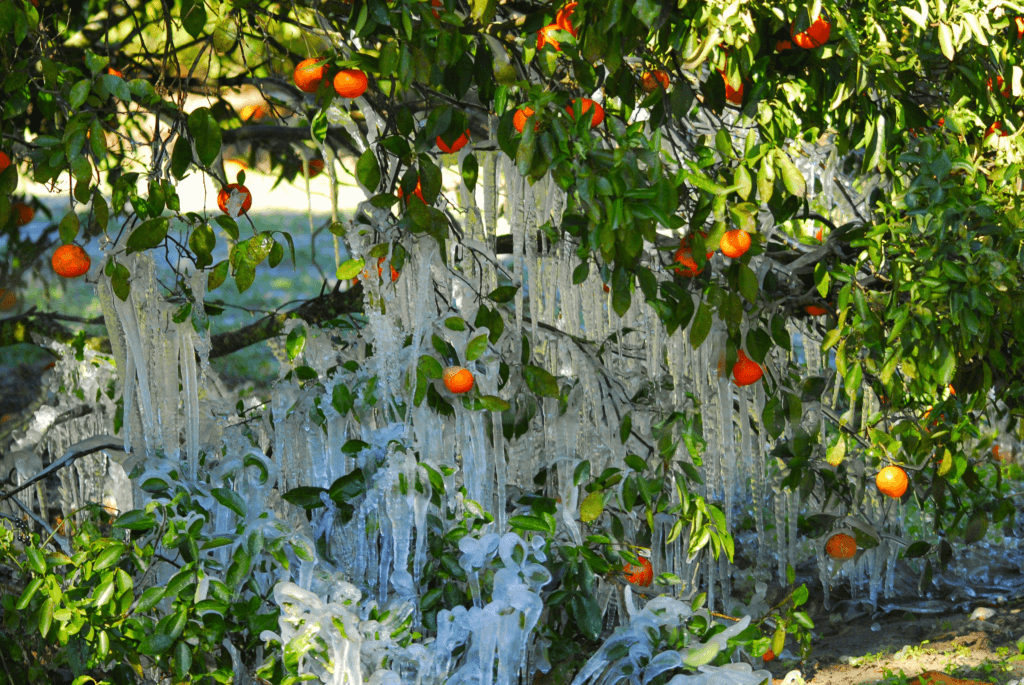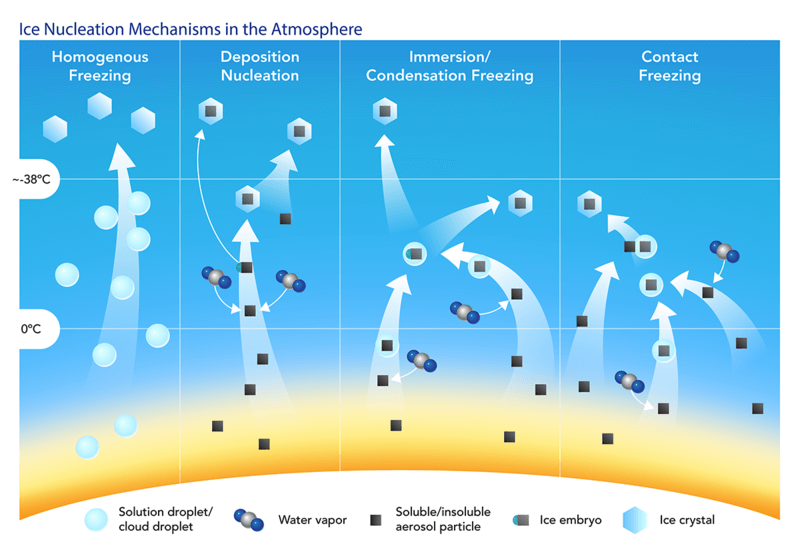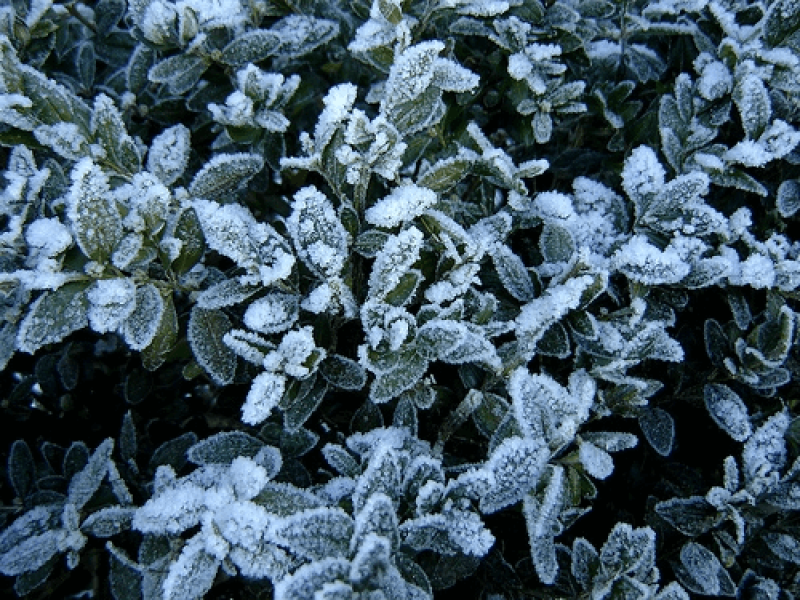Florida is known for destructive hurricanes and torrid heat waves, but at the end of December, some parts of the state experienced many consecutive days of nighttime sub-freezing temperatures and frost. On December 23, fruit farmer and University of Florida Professor of Horticultural Sciences Kevin Folta tweeted, “If you want a good laugh, follow me on Twitter overnight the next 5 days as I attempt to save orchards of fruit trees from frozen death. Water, propane, gasoline, and fire. Should be a hoot.”
Never missing an opportunity for irony, I responded, “C’mon, Kevin, to prevent frost damage, just spray the trees and plants with commercial preparations of ice-minus P. syringae. Oh, wait, I forgot — EPA prevented their commercialization.” For those blissfully ignorant about the vagaries of EPA’s regulation of genetic engineering, this requires some unpacking.
Floridians were not shivering alone. The storm battered most of the eastern half of the country, causing wind-chill factors like -51 F in Chicago, knocking out power to more than a million people, and canceling thousands of flights at just the time people were traveling for the holidays. If there’s a silver lining, it’s that the sub-freezing weather came too early to inflict significant damage on many crops, with a few exceptions, such as citrus and some stone fruits. However, it will take a toll on many common landscaping plants and trees that adorn yards and parks.
Frost damage to crops is not unusual; it causes American farmers to lose billions of dollars annually. Peaches, plums, citrus, and other crops are regularly threatened by frost in the Southeast, but California is also susceptible: A cold snap there in January 2007 cost farmers more than $1 billion in losses of citrus, avocados, and strawberries, and a 1990 freeze caused about $3.4 billion in damage to agriculture and resulted in the layoff of 100,000 citrus industry workers, including pickers, packers, harvesters, and salespeople. In 2002, lettuce prices around the country spiked after an unseasonable frost struck Arizona’s lettuce-growing regions.
As with many of society’s woes, from illnesses to energy production, technology could mitigate much of the damage. But government regulation has placed barriers in the way of many innovative solutions. Those obstacles illustrate what innovators are up against and how flawed, unscientific public policy can prevent science and technology from realizing their potential.
Currently, as Professor Folta alluded to, farmers’ tools for preventing frost damage are pathetically low-tech. Methods include burning smudge pots to produce warm smoke, running wind machines to move the frigid air, and spraying water on the plants to form an insulating coat of ice. An innovative high-tech solution — a clever application of biotechnology discussed below — has been frozen out by federal regulators. (Pun intended.)

In the early 1980s, scientists in the agbiotech (agricultural biotechnology) industry and at the University of California, Berkeley, devised an ingenious approach to limiting frost damage, using recombinant DNA, or “gene-splicing” techniques.
A harmless bacterium, Pseudomonas syringae, lives on many plants and contains an “ice nucleation” protein that promotes frost damage. (Ice nucleation proteins, which are found on the surface of certain bacteria, promote frost damage in plants by inducing the formation of ice crystals at a higher temperature than they would otherwise form.) The scientists created a mutant of the bacterium that lacks the ice-nucleation protein, reasoning that spraying this variant bacterium (dubbed “ice-minus”) on plants might prevent frost damage by displacing the common, ice-promoting strains found in nature. Using very precise recombinant DNA, or “gene-splicing,” techniques, the researchers removed the gene for the ice-nucleation protein. They planned field tests with the ice-minus bacteria to see whether it would prevent frost damage under real-world conditions.

So far, so good. Then the government stepped in.
The Environmental Protection Agency classified the innocuous ice-minus bacterium as a pesticide, which was to be tested in northern California on small, fenced-off plots of potatoes and strawberries. How could they call it a pesticide? The regulators’ rationale was that the naturally occurring, ubiquitous “ice-plus” bacterium promoted frost damage and was, therefore, a “pest,” so other bacteria intended to mitigate its effects would be considered a pesticide. This absurd, sophistic reasoning could lead the EPA to regulate outdoor trash can lids as a pesticide because they deter or mitigate the actions of a “pest” — namely, raccoons.
At the time, scientists inside and outside the EPA agreed that the test posed a negligible risk to humans, animals, or the environment. (I wrote the analysis submitted by the Food and Drug Administration.) They reasoned that no new genetic material had been added — only a single gene whose well-known function had been deleted — and the organism was obviously harmless. Nonetheless, the field trial was subjected to an extraordinarily long and burdensome review by both the National Institutes of Health and EPA only because the organism had been genetically modified with recombinant DNA techniques.
It is noteworthy that small-scale field trials using bacteria with identical traits but constructed with older, cruder techniques require no governmental review of any kind. (There are natural, ice-minus mutants of P. syringae, but because the gene for the ice-nucleation protein is not entirely deleted, the mutation isn’t permanent.) When field-tested on less than 10 acres, non-engineered bacteria and chemical pesticides are completely exempt from regulation.
Moreover, there is no government regulation at all regarding the vast quantities of the “ice-plus” P. syringae organisms (which contain the ice-nucleation protein) that are commonly blown into the air during snow-making at ski resorts (see below).

Although the ice-minus bacteria proved safe and effective at preventing frost damage in field trials, further research and commercialization were discouraged by the onerous government regulation – specifically, the inflated expense of doing the experiments and the prospect of substantial downstream costs, and the stigma of pesticide registration. As a result, the product was never commercialized, and plants cultivated for food and fiber throughout the nation remain vulnerable to frost damage. Professor Folta’s farm is an exemplar: After five days of sub-freezing temperatures, he told me he had “extensive damage to citrus trees that will likely survive, but we’ll lose a lot of fruit in 2023. We had to strip our trees of fruit prematurely, probably $1000 worth that is unsellable,” and “fruit on loquats that froze solid, so no fruit in 2023 from those trees.” Multiply that by thousands of farmers every year in various parts of the country.
We have the EPA to thank for farmers’ jeopardized livelihoods, lost jobs, and inflated produce prices following fall, winter and spring frosts. This point illustrates the ripple effect of such government actions — including the public health impact. The demand for fresh fruits and vegetables is elastic, so higher prices reduce consumption, which causes consumers to get less of the antioxidant, vitamin, and high-fiber benefits afforded by these products. Especially when inflation is boosting food prices, the last thing we need is the continuation of a decades-long, irresponsible, unscientific government policy that lowers crop yields, increases prices to consumers, and threatens farmers’ profits.
The EPA’s disincentives to developing a product that can prevent or mitigate frost damage are yet another example of regulators creating a situation in which everyone loses. Will regulators rethink their policies and be guided by science and common sense? Will Congress take its oversight role seriously and hold EPA accountable? Probably not before hell freezes over.
A version of this article was originally posted at the American Council on Science and Health and has been reposted here with permission. The ACSH can be found on Twitter @ACSHorg































